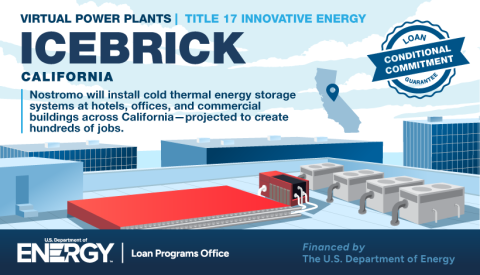
(Nostromo’s IceBrick, the first modular thermal energy storage cell. Courtesy: Nostromo Energy)
The U.S. Department of Energy’s (DOE) Loan Programs Office (LPO) has financed more than $88 billion of innovative large-scale energy projects to date, casting a far-reaching net across a wide range of technologies from coast to coast, in hopes of hauling in a few winners that will spur the energy transition along.
Deemed the “Biden Energy Slush Fund” in The Wall Street Journal, the LPO has dabbled in everything from biofuels to hydrogen production, from onshoring electric vehicle wiring manufacturing to disseminating distributed energy resources.
Project IceBrick, LPO’s latest endeavor, is unique even by its standards.

Not just another brick in the wall
This week, LPO announced a conditional commitment to IceBrick Energy Assets I, LLC, a subsidiary of Nostromo Energy, for a loan guarantee of up to $305.54 million (including $303.69 million of principal and $1.85 million of capitalized interest) to finance Project IceBrick.
Project IceBrick is a virtual power plant (VPP) of up to 193 cold thermal energy storage (TES) installations at commercial buildings across California. The TES cells, a technology Nostromo has been touting since 2018 and the main component of the IceBrick systems, will be manufactured for this project and future U.S. installations entirely domestically by contractors in Texas, Iowa, and California.
The technology is hilariously simple. Basically, it utilizes ice to cool buildings rather than relying solely on air conditioning.

Project IceBrick would provide customers with efficiency as a service by freezing a water-based solution during prime solar generation hours when electricity is at its cheapest and cleanest. The IceBrick system would store and later use the ice to support cooling of the building during hours of peak power demand when electricity production is dirtiest and most expensive.
Nostromo says its nonflammable (duh) IceBrick cells are suitable for both new buildings and retrofits, and their compact and modular design makes them easy to configure into spaces of all sizes.
The company’s Cirrus software platform enables the IceBrick systems to operate as a VPP by orchestrating multiple energy assets to function in concert with one other or participating as individual assets. The resulting flexibility of this load shift technology provides resilient power capacity and serves as a load-stabilizing complement to intermittent clean energy assets, Nostromo contends. Project IceBrick also supports a higher rate of grid asset utilization, tempering electricity costs in a state facing some of the highest electricity bills in the nation.
Nostromo asserts its IceBrick systems would allow California’s bulk power system to avoid up to 500 thousand t





